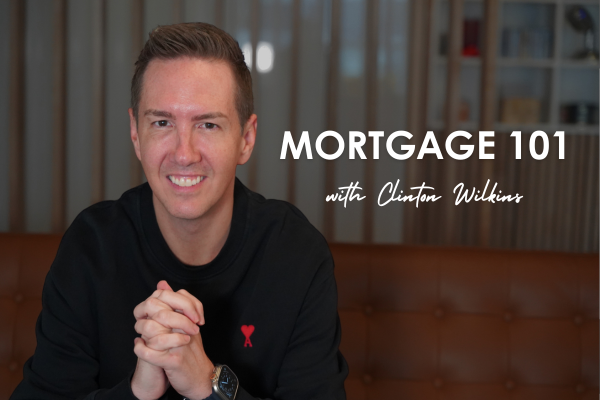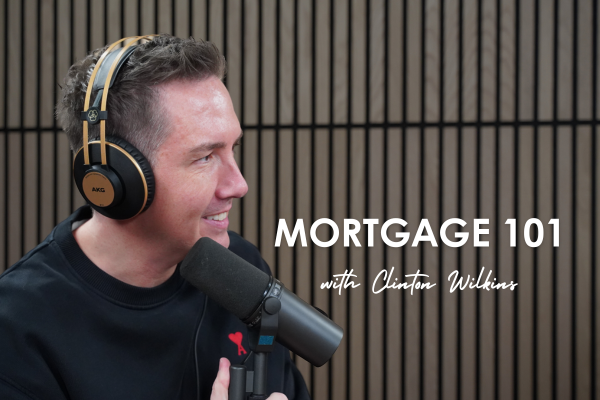Todd Veinotte and Clinton Wilkins discuss the evolving landscape of mortgage lending, highlighting its complexities and the importance of staying informed.
Mortgage 101 – refinance and amortization | June 2022 Part 4
In this episode of Mortgage 101 with Clinton Wilkins and Todd Veinotte, as heard on CityNews 95.7 and CityNews 101.1, the guys talk about refinance and amortization, and how people are getting their children in to the housing market and how people prepare for retirement with their mortgage.
Mortgage 101 with Clinton Wilkins & Todd Veinotte: Refinance and amortization
Don’t feel like watching the video? Check out the transcript below.
Transcript:
Refinance and amortization
Todd Veinotte: [00:00:00:06] All right. So we do want to talk about refinance because we promised that we talk about refinance. How much is refinance? How big of a component of that is out of your business?
Clinton Wilkins: [00:00:10:29] I would say normally it would be less than 50 per cent. Now more than 50 per cent. I’ll tell you the reason, Todd, that we’re doing so many refinances. One, obviously the values are up in our market. So you can refinance up to 80 per cent of the value of your home. So obviously, that’s a component.
Todd Veinotte: [00:00:29:09] Of the appraised value?
Clinton Wilkins: [00:00:30:12] Of the appraised value. And the appraised value is usually what you would sell it for. So a lot of people have quite a bit equity in their home. Even if you bought a home like two years ago, three years ago, usually you have enough equity to refinance right now, based on where the values are. So that’s a reason I think some Canadians are forward thinking and they want to get their finances in order if they continue seeing some inflation.
I’m getting calls for people who want to refinance, clean up maybe some unsecured debt, and extend their amortization. Some are wanting to extend their amortization to 25 or 30 years to bring down their cost of borrowing. And they say, “Hey, Clinton, I’ll just increase my amortization kind of when things settle out or I want to take advantage of lump sum payments down the road.” Yeah, that’s a prudent thing to do.
You know, if your cost of fuel is up, your cost of food is up. If things are tight, but you have a lot of equity in your home, there’s nothing that is not honourable from extending your amortization. So we’re seeing some of that.
Mindsets around refinances are changing
Todd Veinotte: [00:01:29:06] Question for you, before you go on: There was once a mind set, and I don’t know if it was an old school mindset or what, how you would describe it, but you got an amortization and you got that mortgage paid off at that amortization and that was the goal. Pay it off, pay it off, pay it off. There seems to be a different philosophy now that you can be in your fifties, sixties, and if it makes sense to amortize that puppy out for another 25 years, then do it.
Clinton Wilkins: [00:01:56:07] Yeah, trust me, I see it every day. And I see a lot of people going into retirement, Todd that are kind of restructuring their debt, maybe extending their amortization. I have people who are going into retirement that are saying, “Hey, Clinton, I don’t have a lot of a mortgage here, but I’m still working. It’s a great time to kind of do a transaction. Let’s set up a HELOC.”
And they’re paying off their mortgage into a home equity line of credit and they’re like, “I’m never paying this baby off. I want to have some access to credit. You know, I might want to do some renovations. And I’ve also worked really hard my whole life. And, you know, paying this off is just not in my future. And that is okay. I have a lot of equity in this home.” You know, we’re doing stuff like that every day.
Todd Veinotte: [00:02:31:11] So the idea that it was once sacrosanct to do that, to carry kind of debt into retirement in that way, that it just makes sense at that point.
Clinton Wilkins: [00:02:41:05] Exactly. I’m having retired people who are re-upping. You know, I’ve retired people who own their house free and clear and be like, “Hey, Clinton, I want a mortgage for investment purposes,” or “Hey, Clinton, I want a home equity line of credit to do some renovations on my house and make my house what I always wanted it to be. Or maybe it needs to be a little bit more accessible, or I have to do some updates for me to stay in this home.”`
Todd Veinotte: [00:03:01:05] Yeah.
Clinton Wilkins: [00:03:02:08] A lot of families, their home is their biggest asset.
Todd Veinotte: [00:03:04:20] Yeah.
Getting your children in the housing market
Clinton Wilkins: [00:03:05:06] You know, I love when people pay off their mortgage. It feels good to me. But if it’s your biggest asset and you can afford to service the debt. Yeah, why not leverage it? You know what I mean? You know, I think some consumers, I think the thought was, “hey, I need to get this house paid off so I can leave something to my kids.” I think that’s less the concern right now. I have people who are retired are getting up to the retirement age and they said, “I need to get my kids into the real estate market.”
They, you know, they’re 20, 30, 40 years old and they haven’t bought their first home. And they need a lot of help to be able to get into that, you know, get into that real estate ladder. And I have a lot of parents who are refinancing their home or putting a home equity line of credit on their property to give a gift to their kids to be able to get into the real estate market.
And you know, that’s really amazing. I think back in the day there might have been more like multigenerational housing. That was more of a thing. Nobody wants to live with their parents anymore. That’s not cool.
Todd Veinotte: [00:04:05:23] Did anybody ever want to live with their parents?
Clinton Wilkins: [00:04:06:29] Maybe. I think maybe life was too good.
Todd Veinotte: [00:04:10:20] Yeah.
Clinton Wilkins: [00:04:11:09] I don’t know.
Todd Veinotte: [00:04:11:29] Yeah. Well, there you go.
Clinton Wilkins: [00:04:12:26] For me, I grew up in rural Nova Scotia, so I was, you know, really excited to get into Halifax. And, you know, I didn’t live at home as an adult, but I know lots of people who have. And it’s a great thing to do if you’re trying to save money and you have a goal or something like that.
But I think some people just do it because it’s the easy thing. And maybe the parents are like, “We need to get this kid set up.” The kid needs to be self sufficient. The asset for that this child needs, the home, needs to be their biggest asset.
Getting yourself ready for a refinance
Todd Veinotte: [00:04:41:23] So, so what are some of the fundamental things that people can do when they want to go into a refinance? Because there are some things that they can do that that will expedite the process.
Clinton Wilkins: [00:04:52:12] Of course. So, you know, I think documentation is a big thing, Todd.
Todd Veinotte: [00:04:55:14] It sucks doing this stuff, but,
Clinton Wilkins: [00:04:56:25] Yeah, it’s pretty straightforward.
Todd Veinotte: [00:04:58:22] It’s worth the money though doing it?
Clinton Wilkins: [00:04:59:18] Oh yeah, totally. I usually tell people who are like, “Well, how long does it take?” I’m like, “Usually 5 hours is the amount of time commitment that you need, that you need to put in.” Sometimes lasts, sometimes more. You know, have your 2021 annual mortgage statement, have your current property tax bill set aside, have your income confirmation.
So if you’re employed by someone you know, by an employer, have your most recent pay stub, maybe the last two years of your T4s, you know, that’s important. If you’re self employed, you know, maybe connect your unbiased mortgage professional with your accountant and they can give them all the documents. It doesn’t need to be like you’re giving a blood sample.
You know, for us, it’s really easy for existing clients because I can just, you know, copy over the file, do a couple updates, get them to sign a consent form and a brokerage disclosure, and like, Bob’s your uncle. But for new clients, we do it every single day, and it’s honestly a very painless process for many people.
Know how much your house is worth
I think if you have your documents together, documents are the easiest thing. You know, I think the other thing that’s really important, Todd, is to have some type of idea how much your home is worth. I asked people, they’re like, “Oh, I have no idea. I paid $200,000.”
Todd Veinotte: [00:06:03:18] Or a lot of people think their house is worth way more than it is.
Clinton Wilkins: [00:06:06:20] You know what? Right now, I’m not sure. Every time that we have to get an appraisal and obviously a lot of properties go through the automatic valuation system and we don’t need an appraisal. But every time I order an appraisal right now on a refinance, usually I won’t say every time, but usually it comes in higher than what the borrower thought.
Todd Veinotte: [00:06:24:19] Yeah.
Clinton Wilkins: [00:06:25:08] And they’re like, “I’m being conservative. This House is worth $500,000.” comes in at $600,000, $700,000, you know, and it’s based on the comparable sales. You know, and I think sometimes with these automatic valuation systems and I know we touched on this a little bit before, it’s kind of like Goldilocks: can’t be too high, can’t be too low.
It needs to be somewhere in the middle based on what the comparable sales are. And that’s tough, especially in an environment where we’ve seen the values go up so significantly over the last couple of years.
Consolidate your high interest debt
Todd Veinotte: [00:06:55:28] So the refinance is, if you’re carrying high interest debt, my goodness gracious, and you can get that debt rolled over into a new mortgage.
Clinton Wilkins: [00:07:04:20] If you have the equity in the home, now is the time.
Todd Veinotte: [00:07:06:22] Got to be a no brainer, right?
Clinton Wilkins: [00:07:07:27] And now is certainly a good time, especially if you’re in a variable rate already Todd, you touched on it. It’s only three months interest to break it. On a fixed rate, the penalty can be higher to get out of your term. So I think being closer to renewal or at renewal on a fixed rate is probably the right time to do it. But I’m not saying that breaking a fixed rate is never a good idea. Sometimes it is. It kind of just depends on what the situation is.
And sometimes people are doing a refi to change the product. We have a lot of people who will go from a standalone mortgage into a collateral charge type product, and maybe there’s a mortgage and a home equity line of credit. Obviously, that’s becoming more and more popular, especially if you want to have access to the equity, but you don’t want to say borrow the money right away. It’s a good way to kind of get set up.
How to get ahold of Clinton Wilkins Mortgage Team
Todd Veinotte: [00:07:51:22] All right. So a lot of great information. And if people want to know more about all the things that you do or if they want to get a hold of you, they want to do business with you, whatever it might be, what’s the best way?
Clinton Wilkins: [00:08:01:05] I think the best way is to check us out online at TeamClinton.ca/Radio. Lots of great information on there, Todd. Like, we have over 500 blog posts on every single topic you would ever want to know about mortgage lending and if there’s anything you ever want us to talk about on our show, send us a tweet, send me an email, whatever. We’d love to answer your question and thanks for tuning in.
Todd Veinotte: [00:08:23:15] Yeah, absolutely. And we’ll do this next month, of course.
Clinton Wilkins: [00:08:25:24] Yeah. I can’t wait. We’re rolling right into the summer. This is our last show of the spring.
Todd Veinotte: [00:08:30:14] Absolutely. So it’s Your Guide to Homeownership with Clinton Wilkins and myself, Todd Veinotte. Happy to do it. We’ll be back next month.
If you have any questions, get in touch with us at Clinton Wilkins Mortgage Team! You can call us at (902) 482-2770 or contact us here.


